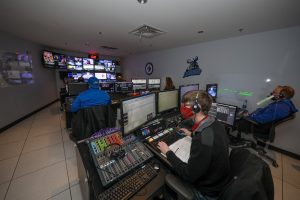At the Rink: Nearly 20 Years in Manitoba, Winnipeg Jets’ Kyle Balharry Reflects on Productions at Bell MTS Place
Despite technological changes, the team remains loyal to its roots
Story Highlights
The National Hockey League was the last of the four major U.S. sports leagues to host a non-bubble regular season. As fans gradually make their return to the seats, how is that affecting in-venue productions and digital content? Similar to At the Ballpark, On the Gridiron, and On the Hardwood, At the Rink looks at the operations of NHL organizations to see how they are coping with the ongoing COVID-19 pandemic and adapting to a sense of normalcy.
The province of Manitoba is built on its Indigenous heritage and a deep connection to nature. Forged in the cold of central Canada, the capital of Winnipeg is an ample location for the most ardent of hockey fans. Senior Director, Game Production Kyle Balharry has witnessed this city’s attachment to the game since the early 2000’s, and now well into the 2020-21 season, he’s led the transformation of franchise’s in-venue production strategy.
“It’s a different season so far than any other that I’ve worked in my day,” he says. “When there are fans in the building, there are a lot of commitments that you have to do, but without any of those happening, we’ve got more time to fill.”
MORE AT THE RINK INTERVIEWS:
- Tampa Bay Lightning’s Stanley Cup Banner Ceremony Serves as Reminder of Normalcy During Unusual Year
- Montreal Canadiens Transform Bell Centre Into Blank Canvas for Linear Broadcast
- Philadelphia Flyers Flex Potential of 4K Kinetic Centerhung as Fans Return to Wells Fargo Center
- Chicago Blackhawks Leverage Relationship With NBA’s Bulls for Fan-Less Show at United Center
- Toronto Maple Leafs Follow Production Blueprint From 2020 NHL Bubble at Scotiabank Arena
- Anaheim Ducks Catch Attention of Fans Through The Flying V Experience, Reverse Retro Content
- Detroit Red Wings Cover Motor City Storylines With Three Digital Shows, Hockeytown Home Ice
- In NHL’s North Division, Calgary Flames Keep Battle of Alberta Alive in Empty Scotiabank Saddledome
- Carolina Hurricanes Sidestep Water Leak To Welcome Fans Back to PNC Arena
- Washington Capitals Approach Regular Season With Virtual Gameday Digital Experience, Traditional In-Venue Flair
- Top-Ranked Colorado Avalanche Revel in the Return of Fans
- During First Two Months on the Road, San Jose Sharks Develop Engaging Content in Different Ways
- Los Angeles Kings’ Wanton Davis Adjusts to His First NHL Season During the COVID-19 Pandemic
- Vegas Golden Knights Offer Fortress At Home, Debut Studio for 2020-21 NHL Season
- Inside the Dallas Stars’ Wild Month of March
- Nashville Predators Harness the Passion of ‘Smashville’ at Bridgestone Arena
A Manitoba Lifer: The Evolution of In-Production Since the Team’s Return in 2011
Fans of any sport are pleasantly surprised when an athlete stays with a single organization throughout the entire duration of their career. Even though Balharry isn’t wearing a pair of skates, he’s one of those individuals. After growing up in the province, specifically in Winnipeg, he grew up rooting for the previous incarnation of the Jets before their eventual move to Phoenix in 1996. He eventually got his start with the franchise’s affiliate in the American Hockey League, the Manitoba Moose, in the early 2000s. During his early years on the job, his passion for sports production was ignited by segments he watched on television.
“I remember a few pieces about a couple of women from Winnipeg that were doing game production in San Jose, and it was a really interesting story,” he says. “I think it opened a lot of people’s eyes that there is more than just the game itself.”
A few years later, when the Atlanta Thrashers moved to Winnipeg and revitalized the Jets’ branding in 2011, he saw his opportunity to work for his childhood club and made the jump to the big leagues. He holds a lot of reverence for his current position, but it’s a responsibility that he doesn’t take lightly to promote the diverse culture that the region has to offer.
“We’ve been extremely blessed to have one of the best hockey environments because this sports is in our blood,” says Balharry. “It’s our obligation to present the game of hockey in a positive light and highlight its traditions.”
The Current State of Bell MTS Place: Empty Seats Call for Player-Centric Content

Bell MTS Place is still being lit up to honor the 10-year anniversary of the Jets’ return to Winnipeg.
Like many circumstances in life, a lot of lessons learned in the past have a residual effect in the present and future. No one in the history of National Hockey League has had to produce games in home stadiums without fans before. In an unforeseen season like this current one, it’s imperative to rely on the resourcefulness of yourself and the entire team. Throughout this time of experimentation, Balharry has been able to recall on his long history in this field and his ability to adapt to the advent of new technologies along the way.
“From the audio you hear in the bowl to the interactive content you have with the players, there have been a lot of changes since 2000, so if we only stay within our traditions, we’re going to be passed by really quickly,” he adds. “Our building will continue to grow with technology and new ways to interact with the fans.”
As a response to new technologies, like fabricated crowd noise controlled by Coordinator, Game Presentation Priya Plested, the Jets’ production team is generating a show that caters mostly to the players down on the ice. These elements include collaboration with players on music playlists and data-driven graphics.
“We have a lot of information to the point where we actually bumped up all of our stats onto the videoboard, so that the players, media, scouts, and coaching staff can actually see them,” he continues. “We also have some player pump-ups to energize the players a little bit.”
In a way to get the fans at home involved in the action, the Jets have gone down the digital route through a mobile application. Through a partnership with Fannex and the club’s digital team, the Jets mobile app and website has gained significant traffic during the course of each game. Interactive games like real-time trivia and other elements have kept fans engaged during stoppages in play.
The Ones Who Get It Done: Notable Names of Jets’ Production Team
Due to the longevity of Balharry’s production career, he’s had the chance to work with some colleagues for a long period of time, including Manager, Visual Media Production Steve Godkin for 15 years and PA Announcer Jay Richardson for 20 years. Others, including Director, Audio Video & Broadcast Services Noah Baird; Audio Video & Broadcast Technician Joe Etchells; Broadcast Engineer & Senior Technician Richard Romanow; Replay Operator and Video Director Janice Labossiere; and Video & Motions Graphics Producers Aidan Padgett Reimer and Ievgen Komashko, are some of the newer professionals that he’s been able to work with. When you work 900 consecutive home games, including a deep run to the 2017-2018 Western Conference Finals, it’s hard to not be engrained into the very fiber of this organization. Now in his 10th year to the franchise, Balharry has surrounded himself with a core group of individuals that will inspire the next generation of production professionals in Winnipeg.
“Everybody on our game presentation team has been touched by hockey,” he concludes. “It’s exciting to know that I’ve literally been working with almost the entire same unit for 15 years. It’s a special thing because a lot of other arenas and cities don’t get that chance to have a team that stays together like that. You can imagine how awesome it is to be able to feed off each other.”
After a three-game stint in Calgary, the Winnipeg Jets will return to Bell MTS Place to play two games in three games against the Toronto Maple Leafs on Wednesday, March 31 at 7:30 p.m. ET and Friday, April 2 at 8 p.m. ET.


